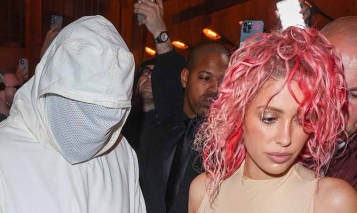
In a bizarre Snapchat video uploaded to Kim’s Snapchat page on Instagram.com, music producer Kanye West stands frozen like a statue while his wife, Kim Kardashian and their son, Saint West, play with Snapchat filters on her cell phone.
“I’m a dog too,” says Kim, as her son is fascinated by the dog filter. “Let daddy be a dog,” says Saint, reaching for the camera to record his father — who is standing motionless behind them, as the camera cuts off.
Kim’s followers were shocked by Kanye’s abnormal frozen posture, which may or may not be a sign of Tardive Dystonia — a drug-induced movement disorder that is characterized by abnormal movements of the body and/or stiff postures.
Kanye, 41, suffered a nervous breakdown and was hospitalized in California in 2016. On a track off his album, Ye, Kanye revealed he was diagnosed with bipolar disorder. He is often described as “off is meds” when he displays bizarre behavior in public.
He was recently rushed to the emergency room for what Kim described as “antibiotics for the flu”. Influenza is caused by a virus and is not treated with antibiotics.
What is Tardive Dystonia?
People affected by tardive dystonia experience involuntary, and usually painful, spasms and muscle contractions of the entire body. It is not the same as tardive dyskinesia which is also an involuntary movement disorder that affects the mouth, tongue, eyebrows, eyelids, fingers, hands, arms, legs, and/or torso.
Tardive dystonia affects psychiatric patients who have been on anti-psychotic medications for weeks, months or years. The condition is permanent and persists long after the medications are discontinued.
What Type of Drugs Induce Tardive Dystonia?
Drugs that are known to induce tardive dystonia include Risperdal, Thorazine, Haldol, Lithium, anti-depressants categorized as selective serotonin reuptake inhibitors (SSRIs), tricyclic anti-depressants (TCAs), anti-nausea medication Reglan, and more.
Treatment of Tardive Dystonia
There is no cure for tardive dystonia or tardive dyskinesia. Treatment of symptoms include Vitamin E, Benadryl (diphenhydramine), Botulin toxin injections (Botox), and neurotropic drugs to help combat the movement disorders such as jerking, spasm, and stiffness.
Watch the YouTube video below that shows signs of tardive dystonia and tardive dyskinesia.
https://www.youtube.com/watch?v=rxzvLjdN5nc
DISCLAIMER
Any medical information published on this blog is for your general information only and is not intended as a substitute for informed medical advice. You should not take any action before consulting with your personal physician or a health care provider. We do not claim to have knowledge of an individual’s medical history or current medical or psychiatric diagnosis. Sandrarose.com and its affiliates cannot be held liable for any damages incurred by following information found on this blog.




